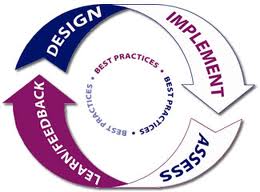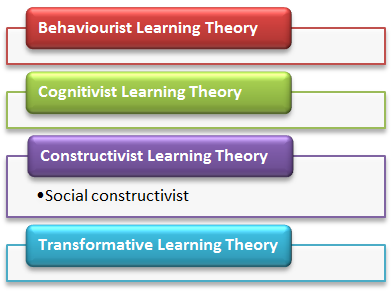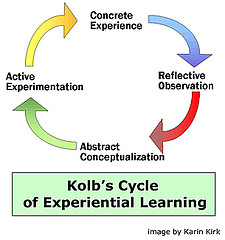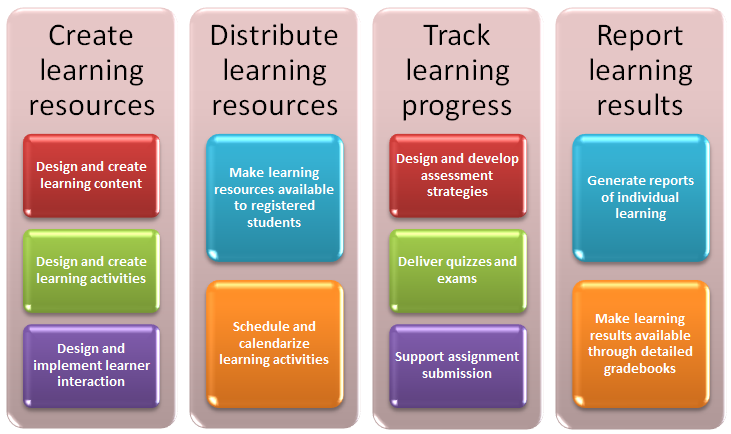Quality Framework and Learning Theory
| Site: | Technology-Enabled Learning Lounge |
| Course: | Developing & Teaching Online Courses |
| Book: | Quality Framework and Learning Theory |
| Printed by: | Guest user |
| Date: | Friday, 26 December 2025, 11:07 AM |
Description
This book will guide you through ....................
The learning activities for this section are listed below for your convenience but are also accessible from within the book.
Quality Framework

CC by SA 3.0 Source:
http://decreasing-chf-readmission.wikispaces.com
/Best+Practices+Recommendations
In this section, you will discuss a set of best practices aimed at guiding the design and implementation of online and blended courses. A word of caution about 'best practices' is that what is best for one institution, may not be the best for another, especially when the learning contexts are varied. Therefore, it is important to discuss and assess best practices in relation to institutional contexts as well as learning and teaching needs. Having said this, learning from 'best practices' offers value in that it should inform and guide course design. The premise being that best practices are the result of successful implementation that can be extrapolated to new educational contexts.
With this in mind, the aim for the work that you will do in this section is to have you think and reflect on best practices, reach a consensus with your peers as to what best practices may mean for your own context and agree on what best practices you will implement as part of your online or blended course.
Criteria for Best Practices
The term 'best practices' has certainly become a 'buzzword' in education and training. Its meaning can be muddled at times, meaning different things to different people. And that is ok. If we consider that:
...best practices represent a methodology of sorts that over time consistently demonstrates reliable and above average results in comparison with other means, then it can be used as a benchmark for measuring quality outputs.
Best practices are not 'written in stone' and will continue to change as we experiment with new techniques in teaching and learning. It is in this context that we would like to share with you a set of criteria to guide best practices in the design and development of online and blended learning.

Activity
Take some time to analyse the criteria for each of the six components:
- Learner Support and Resources
- Instructional Design
- Online Organization and Design
- Innovative Teaching with Technology
- Assessment and Evaluation of Learning
- Learner Feedback
Then post your thoughts in the best practices and quality framework discussion forum.
Characteristics of Quality Online and Blended courses
There is much literature on the characteristics that define quality online learning. Many authors speak to the course structure and organisation, to the levels of learner engagement and the types of assignments. We will provide a few web resources below if you are interested in reading more about this. However, in your discussions about a quality framework, you most likely came to a few conclusions of what quality means to you, within the context of your course. Based on that, you will implement your own quality framework to support your design.
Although it is good to rely on best practices, as they demonstrate what has worked best in the past, no online or blended course is equal in the need they address or the audience they reach. One size does not fit all in online teaching and learning and relying on a set formula will jeopardize quality. Each course will have different characteristics that will define quality within the context it is delivered.
Assignment
It is now time for you to define what quality will mean for your course! Based on the discussions you had with your peers, create a checklist with the criteria you will follow as you design and implement your course and upload it to the Quality Checklist assignment box.

Example
You may use this example of a checklist as a guide to build your own. Remember that the checklist will vary somewhat from course to course, as a criterion that is applicable to one course may not necessarily be appropriate to a different course. However, most of the criteria should be applicable to most online courses you develop, so you only have to do this work once, and then just adapt it and re-use it.
The following web resources discuss various premises of quality for online and blended courses. The Chickering and Gamson paper is particularly interesting in that it focuses on a seven principles aimed at improving learning experiences in higher education which are applicable to both face-to-face and online learning environments.
The Basics of Learning Theory
In this section you will briefly explore the basics of learning theory, focusing on the four main theories that have shaped the design of online learning over the last few decades:


(CC BY-NC-SA 2.0)
Kolb's learning cycle provides insight into adult learning characteristics which focus on experiential learning. Kolb's cycle involves four different stages of learning from experience that can be entered at any point. As learners experience, they reflect, conclude and experiment in order for successful learning to take place.
Learning theories have influenced the pedagogy that underpins learning management systems (LMS), and in this section you will explore the pedagogy behind Moodle.
The Learning Process
There is a vast body of literature about learning theory and probably as many definitions of what learning is. As a conceptual framework, learning theory aims to explain how we perceive, process, store, retrieve, reuse and transform information. Many theories have been put forward over the last century, but we will briefly gloss over the few that have represented the mainstream of this body of knowledge. Before we do that, though, if you think about what learning is, you will realise that
... it is an internal, staged mental process, unique to an individual. It cannot be observed, but can be recognized externally.
You would agree that we can't really see when or how learning is happening. As teachers, we cannot look at someone and say: "Hmmm... this person is learning. I can see it!" We have to have some behavioural demonstration that learning has in fact occurred. You would also agree that although the physical process of perceiving information and storing it into memory may physically develop in the same way, individuals process information in their unique ways. We all have preferred ways in which we learn. These are sometimes referred to as learning styles, but beware of labelling students and putting them into these 'learning styles buckets'. The following video puts forward the notion that learning styles don't exist. Whether you agree or disagree, it makes you think about good teaching.
Learning is not only about receiving stimuli and storing information; rather, it's about the meaning: how we connect existing and new information and how we transform it to serve our individual learning needs.
Characteristics of Adult Learners
Malcolm Knowles introduced the premise that adult learners have specific characteristics that will impact how they learn:
- Adults need to have a reason to learn and know why they are learning
- Adults bring a wealth of experiences and prior learning to new learning situations
- Adults are self-directed learners: they take responsibility for their own learning
- Adult learning focuses on solving "real world" problems
- Adults are motivated to learn by personal factors, and they choose to learn when they are ready to learn
- Adults are more engaged if learning is contextual, relevant and involves practical application
Although it is important to keep these characteristics in mind when designing learning for adults, it is also important to note that not all adult learners have these characteristics. In fact, you may find that many adult learners aren’t very self-directed and often need handholding and direction.

Reading Activity
- This section of Freeman's book "Creating Learning Materials for Open and Distance learning: a Handbook for Authors and Instructional Designers", available from the COL website, offers some good examples of the characteristics of adult learners.
- Freeman's book "Creating Learning Materials for Open and Distance learning: a Handbook for Authors and Instructional Designers" is a great resource for consultation only.
- This paper from the proceedings of The Internet Society conference in 1996 is still valid today, as we continue to address changing educational paradigms. The paper is underlined by Knowles' principles of adult learning and focuses on the implications for content designers.
When designing learning for adults, showing through the use of examples, rather than just telling, will engage learners in richer, more meaningful learning experiences.

Web Resources: Optional Reading
If you are interested in reading some more about learning theory and adult learner characteristics, here are some additional resources:
- Knowles andragogy and adult learning principles
- Approaches to clinical education - this site addresses the adult learning principles and provides some good examples of teaching approaches
- Learning theory
- Various learning theories
Collaboration and Social Learning
Over the last four decades, the body of knowledge around learning theory has evolved from considering the learning process from an individual perspective to emphasizing the importance of social networks and collaboration in the way we learn. Bandura (1977) states:
"Learning would be exceedingly laborious, not to mention hazardous, if people had to rely solely on the effects of their own actions to inform them what to do. Fortunately, most human behavior is learned observationally through modeling: from observing others one forms an idea of how new behaviors are performed, and on later occasions this coded information serves as a guide for action." (p22).
The rapid growth and development of information and communication technologies (ICTs) over the last two decades has greatly enabled the growth of collaborative environments and the expansion of social networks, supporting the tenets of collaborative and social learning theory.
"Research shows that collaborative learning compared to individual and competitive learning scenarios brings students to a higher achievement level, raises their problem-solving abilities, offers cognitive advantages to learners and also has positive influences in enhancing the development of personality traits that are beneficial for future learning or future autonomous or co-operative learning and working (Tozer S. E. et.al. 1995; Webb, N. 1984; Bargh, J.A.; Schul, Y. 1980)."
In "Social Aspects of Collaborative Learning in Virtual Learning Environments"
The LMS
Learning Management Systems (LMS) are Web-based software applications that do just that: they manage learning and the delivery of learning resources. In doing so, these applications allow educators to:


Examples
Moodle is one of the most widely used LMS in the world. It is a free, open source LMS, that fosters constructivist approaches to teaching and learning. Moodle offers great flexibility in the way learning content and resources can be introduced as well as a comprehensive set of tools for learner engagement and collaboration. You will learn all about Moodle in the next sections of this course.
The Teaching Philosophy of the LMS
By making available a variety of tools to enable rich communications, such as discussion forum, blogs, chat rooms and even e-mail, LMS enable higher levels of student engagement in the learning process. Relying on good course design, instructors have the opportunity to guide learners through discovery, reflection and collaboration. They can be the guides on the side enacting student-centric teaching approaches that enable students to think through situations while constructing their own knowledge. The variety of tools available through a LMS permit the design of comprehensive assessment strategies, tailored to specific learning situations. Instructors can design structured quizzes using a multitude of question types at one end of the spectrum, or collaborative group projects that focus on application of learning to specific situations. Accessibility over the Internet provide both instructors and learners with great flexibility to teach and learn virtually anywhere, anytime.
The LMS allows for highly structured as well as non-structured learning environments. The teaching philosophy behind most LMS is one of flexibility and choice, allowing teachers to use the teaching approaches that may be best suited for their learners, the subject-matter and the context in which their courses are offered. From approaches that are focused on knowledge transmission to the ones that fuel knowledge creation, the LMS offers a wide spectrum of possibilities. However, the default approaches used in most LMS tend to be transmission oriented with a great focus on the content. Taking advantage of the constructivist approaches that are enabled by LMS requires good learning design, that focus on knowledge creation and engagement.

Web Resources: Optional Reading
If you are interested in learning more details about LMS, have a look at the following resources:
This online course is available to you through Moodle, a free open source LMS. There are many LMS, some free some proprietary. The following sites list the most commonly used LMS:
The Pedagogy Behind Moodle
Moodle is a Learning Management System (LMS) that fosters a constructivist approach to teaching and learning. It is a Web-based application that allows for the creation, distribution and management of courses over the Internet. This short video gives you an idea of what you can do with Moodle:

Web Resources
The Moodle site provides a great overview of the LMS. Make sure you visit the demonstration sites and watch the Moodle presentation video.
Pedagogical Approach
Using Moodle to teach fosters a social constructivist approach to teaching and learning.
"Constructivism assumes that students learn as they work to understand their experiences and create meaning. In the social constructivist model, teachers are knowers who craft a curriculum to support a self-directed, collaborative search for meanings. According to Siemens "Constructivist principles acknowledge that real-life learning is messy and complex. Classrooms which emulate the 'fuzziness' of this learning will be more effective in preparing learners for life-long learning." However, this open-ended process is still a linear one founded on objectives that reflect what experts have decided learners should be learning."
Siemens, G. 2005. Connectivism: A learning theory for the digital age. International Journal of Instructional Technology and Distance Learning 2 (1). http://itdl.org/Journal/Jan_05/article01.htm (accessed May 27, 2008). Archived at http://www.webcitation.org/5Xuh37vbA.
The social constructionist philosophy that underlies Moodle asserts that learning occurs particularly well in a collaborative environment that both students and teachers build together.
Moodle is an open source application, which means that its source code is available to the general public for use and/or modification from its original design free of charge. Open source code is typically created collaboratively by programmers who improve the code and share it with the community.

Activity
There is a large Moodle community that shares tips and resources on how to use the LMS. Take some time now to register in the community by registering for the Using Moodle forum and explore the site. Once you register you can engage with other Moodle users, learn about features and tips and ask questions. The community is fairly swift to respond.
This brings you to the end of Module 3: Quality & Learning. Next you will get started with the planning stage for your online or blended course as you begin your study of Module 4. If you have any questions about the content covered in Module 2, please feel free to post them to the Course Q&A discussion.
